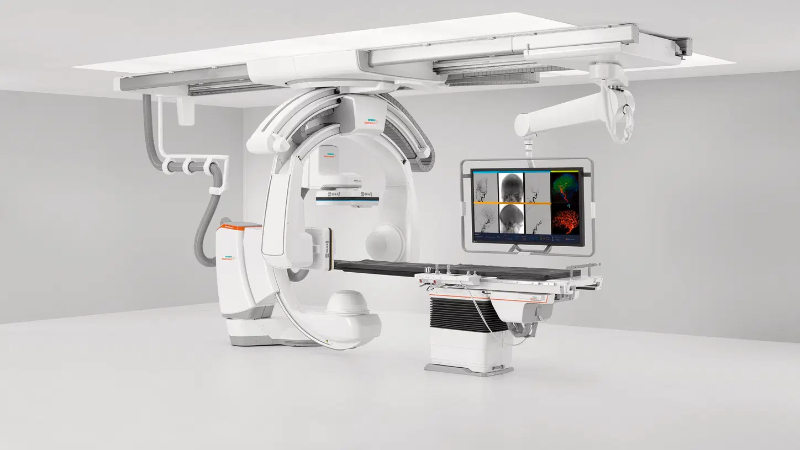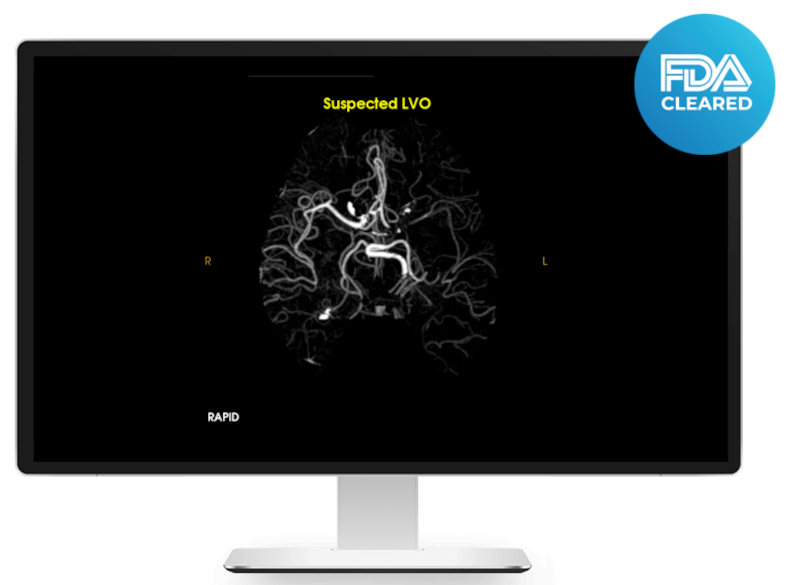Diagnosis and Treatments
To determine if you are having a stroke, we perform a physical examination, checking for signs like drooping facial muscles, inability to lift an arm, slurred or jumbled speech. We then use advanced procedures and technology to decide if you are having, or had, a stroke. Based on the results, we talk about treatment options and carefully monitor your condition.
Diagnostic procedures can include
Biplane Angiography

Deaconess offers the region’s only Artis ICONO Biplane technology for advanced stroke treatment.
Biplane imaging is the world's most advanced interventional medical imaging technology. This digital X-ray process uses two rotating cameras, one on each side of the patient. The cameras move side-to-side and front-to-back, producing images that detail soft tissue and vessel anatomy to a degree that was previously impossible. The two sets of images form a three-dimensional portrait for the physician.
Biplane imaging allows physicians to create a "roadmap," following the path of blood flow through the patient's vessels to reach and treat the exact location of malformation or disease.
Blood Tests
These can tell physicians and emergency staff how fast a person’s blood clots, if blood sugar is abnormally high or low, if blood chemicals are out of balance or if an infection is present.
Carotid Ultrasound
In this test, sound waves create images of the carotid arteries in the neck, showing blood flow and buildup of fatty plaques.
Cerebral Angiogram
During this procedure, the physician inserts a thin, flexible catheter into a large artery — typically in the groin — and threads it past the heart to the arteries in the brain. He or she then injects a special dye into the catheter that travels to arteries throughout the brain. A series of X-ray images can then reveal details about the condition of the arteries.
Computerized Tomography (CT) Scan
This test uses X-rays and computers to create images of the brain. Sometimes, contrast dye is injected to make bleeding in the brain easier to see.
Echocardiogram
This test uses sound waves to create detailed images of the heart and can find a source of clots in the heart that may have led to a stroke.
Magnetic Resonance Imaging (MRI)
This test uses a powerful magnet and radio waves to produce images of the brain. It can detect bleeding in the brain and damage to brain tissue caused by an ischemic stroke.
RAPID-AI
This technology automatically processes CT scans to quickly deliver clear CT angiography images — automatically removing bone and non-vascular tissue and creating 3D vascular reconstructions to deliver clear views of the brain and easy-to-interpret color-coded results. In as few as three minutes, RAPID LVO helps physicians quickly identify suspected large vessel occlusions (LVOs) to help speed triage decision making and facilitate better patient outcomes.

RAPID-AI technology facilitates fast identification of suspected LVOs to streamline triage and transfer decisions.
Treatment for a Hemorrhagic Stroke may include
Emergency Interventions
In the emergency room, a person suffering this type of stroke may be given drugs to counteract the effects of blood thinners, reduce pressure in the brain, reduce blood pressure, prevent seizures or prevent spasms of the blood vessels. When bleeding stops, a person will receive supportive medical care.
Surgery
In some cases, the surgeon may need to remove blood and relieve pressure in the brain. Surgery can also repair blood vessel abnormalities associated with these types of strokes and may include clamping of the aneurysm, inserting a coil into an aneurysm, surgical removal of an aneurysm, and performing a surgical bypass of intracranial blood vessels to improve blood flow.
Treatment for an Ischemic Stroke may include
Emergency Procedures
A surgeon may use a catheter to insert a tiny device to break up or remove a clot and/or deliver clot-busting drugs directly into the area where a stroke is occurring.
Emergency Medications
Therapy with clot-busting drugs administered within three hours of a stroke’s development can be very effective in ensuring survival and reducing complications. Some people may also be given aspirin to reduce the likelihood of another stroke or an injection of recombinant tissue plasminogen activator (TPA), which restores blood flow by dissolving a clot.
Other Procedures
A surgeon may remove plaques from carotid arteries in the neck or insert a balloon to expand the artery and insert a stent to improve blood flow.
After a Stroke
Depending on stroke complications, many patients require
rehabilitation services. Some may benefit from outpatient occupational, physical or speech therapy. Others may require hospital-based rehabilitation.
As a Joint Commission certified hospital in Stroke Rehabilitation, Encompass Health Deaconess Rehabilitation Hospital takes a team approach for each patient, with an individual treatment program that combines the latest rehabilitation technology with proven therapy techniques to give each patient the specialized care they need to recover.